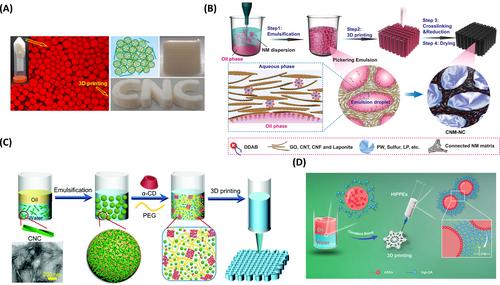Chia-Min Hsieh, Ciera E. Cipriani, Emily B. Pentzer
下载PDF
{"title":"固液混合结构的三维打印","authors":"Chia-Min Hsieh, Ciera E. Cipriani, Emily B. Pentzer","doi":"10.1002/pi.6636","DOIUrl":null,"url":null,"abstract":"<p>3D printing is a versatile technology for creating objects with custom geometries and compositions and is increasingly employed for fabricating hybrid solid–liquid composites (SLCs). These composites, comprising solid matrices with integrated liquid components, showcase unique properties such as enhanced flexibility and improved thermal and electrical conductivities. This review focuses on methods to fabricate SLCs directly by different 3D printing techniques, e.g. without needing to backfill or impregnate a porous matrix. The techniques of extrusion, vat photopolymerization and material jetting combined with microfluidics, inkjet printing, vacuum filling and ultraviolet light curing to produce SLCs are emphasized. We also discuss the development of feedstocks, focusing on emulsions and polymer capsules as fillers, and analyze current literature to highlight their significance. The review culminates in a perspective on new directions, highlighting the potential of bicontinuous interfacially jammed emulsion gels (bijels) to facilitate the printing of continuous liquid pathways, alongside the importance of understanding ink formulation and stability. Concluding with future perspectives, we underline the transformative impact of 3D-printed SLCs in diverse applications, signaling a significant advancement in the field. © 2024 The Authors. <i>Polymer International</i> published by John Wiley & Sons Ltd on behalf of Society of Industrial Chemistry.</p>","PeriodicalId":20404,"journal":{"name":"Polymer International","volume":"73 10","pages":"793-802"},"PeriodicalIF":2.9000,"publicationDate":"2024-04-02","publicationTypes":"Journal Article","fieldsOfStudy":null,"isOpenAccess":false,"openAccessPdf":"https://onlinelibrary.wiley.com/doi/epdf/10.1002/pi.6636","citationCount":"0","resultStr":"{\"title\":\"3D printing of hybrid solid–liquid structures\",\"authors\":\"Chia-Min Hsieh, Ciera E. Cipriani, Emily B. Pentzer\",\"doi\":\"10.1002/pi.6636\",\"DOIUrl\":null,\"url\":null,\"abstract\":\"<p>3D printing is a versatile technology for creating objects with custom geometries and compositions and is increasingly employed for fabricating hybrid solid–liquid composites (SLCs). These composites, comprising solid matrices with integrated liquid components, showcase unique properties such as enhanced flexibility and improved thermal and electrical conductivities. This review focuses on methods to fabricate SLCs directly by different 3D printing techniques, e.g. without needing to backfill or impregnate a porous matrix. The techniques of extrusion, vat photopolymerization and material jetting combined with microfluidics, inkjet printing, vacuum filling and ultraviolet light curing to produce SLCs are emphasized. We also discuss the development of feedstocks, focusing on emulsions and polymer capsules as fillers, and analyze current literature to highlight their significance. The review culminates in a perspective on new directions, highlighting the potential of bicontinuous interfacially jammed emulsion gels (bijels) to facilitate the printing of continuous liquid pathways, alongside the importance of understanding ink formulation and stability. Concluding with future perspectives, we underline the transformative impact of 3D-printed SLCs in diverse applications, signaling a significant advancement in the field. © 2024 The Authors. <i>Polymer International</i> published by John Wiley & Sons Ltd on behalf of Society of Industrial Chemistry.</p>\",\"PeriodicalId\":20404,\"journal\":{\"name\":\"Polymer International\",\"volume\":\"73 10\",\"pages\":\"793-802\"},\"PeriodicalIF\":2.9000,\"publicationDate\":\"2024-04-02\",\"publicationTypes\":\"Journal Article\",\"fieldsOfStudy\":null,\"isOpenAccess\":false,\"openAccessPdf\":\"https://onlinelibrary.wiley.com/doi/epdf/10.1002/pi.6636\",\"citationCount\":\"0\",\"resultStr\":null,\"platform\":\"Semanticscholar\",\"paperid\":null,\"PeriodicalName\":\"Polymer International\",\"FirstCategoryId\":\"92\",\"ListUrlMain\":\"https://onlinelibrary.wiley.com/doi/10.1002/pi.6636\",\"RegionNum\":4,\"RegionCategory\":\"化学\",\"ArticlePicture\":[],\"TitleCN\":null,\"AbstractTextCN\":null,\"PMCID\":null,\"EPubDate\":\"\",\"PubModel\":\"\",\"JCR\":\"Q2\",\"JCRName\":\"POLYMER SCIENCE\",\"Score\":null,\"Total\":0}","platform":"Semanticscholar","paperid":null,"PeriodicalName":"Polymer International","FirstCategoryId":"92","ListUrlMain":"https://onlinelibrary.wiley.com/doi/10.1002/pi.6636","RegionNum":4,"RegionCategory":"化学","ArticlePicture":[],"TitleCN":null,"AbstractTextCN":null,"PMCID":null,"EPubDate":"","PubModel":"","JCR":"Q2","JCRName":"POLYMER SCIENCE","Score":null,"Total":0}
引用次数: 0
引用
批量引用


 求助内容:
求助内容: 应助结果提醒方式:
应助结果提醒方式:


